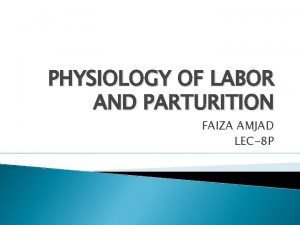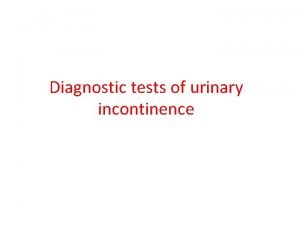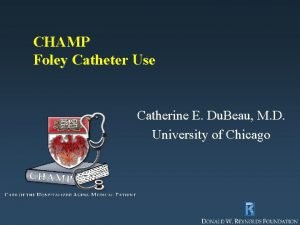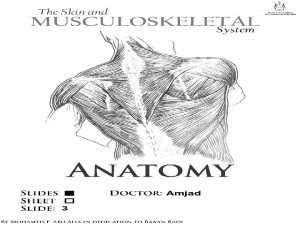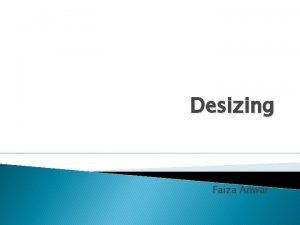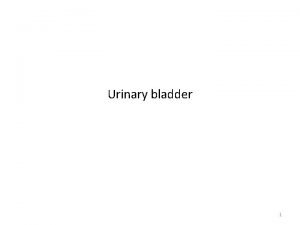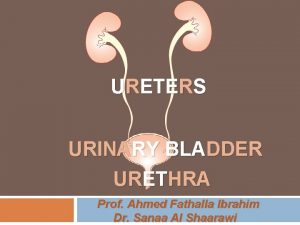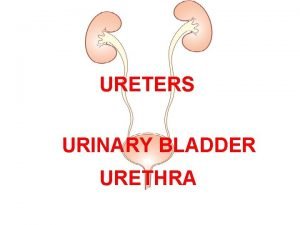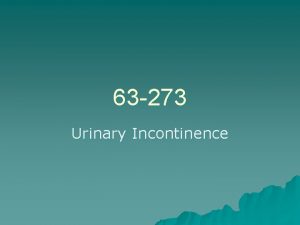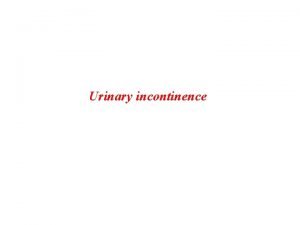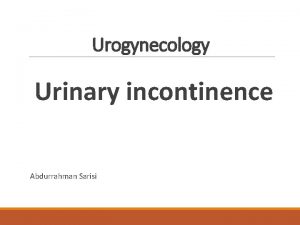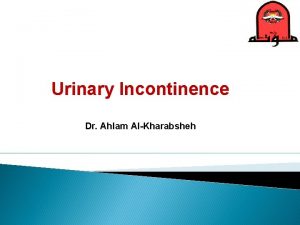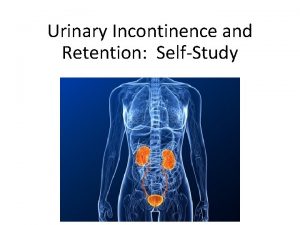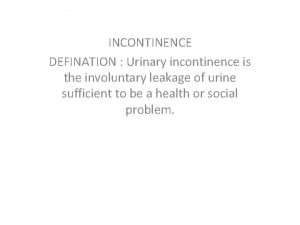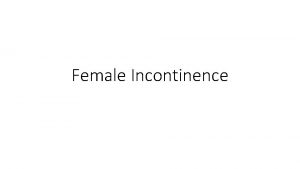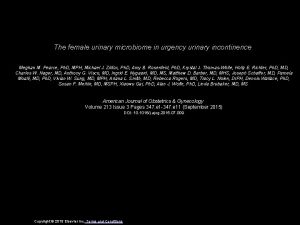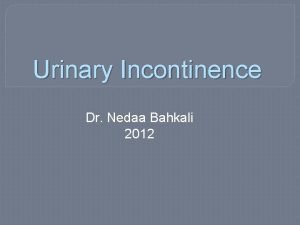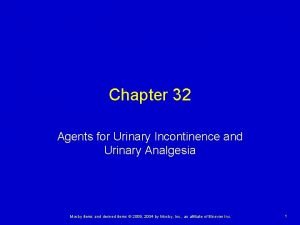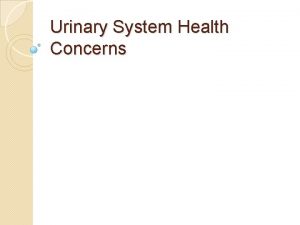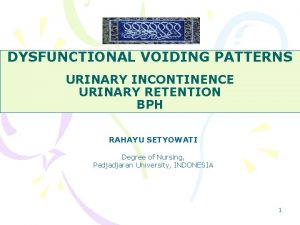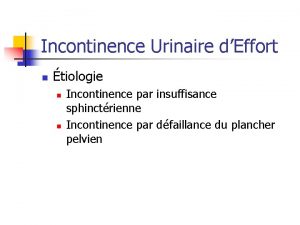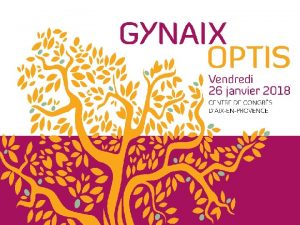URINARY INCONTINENCE Faiza Amjad Definition UI is the























- Slides: 23

URINARY INCONTINENCE Faiza Amjad

Definition • UI is the involuntary loss of urine that is objectively demonstrable and a social or hygienic problem. International Continence Society

Consequences of UI Cellulitis, Pressure ulcers, UTI Falls with fractures Sleep deprivation Social withdrawal (Isolation) , depression Embarrassment (50%), interference with activities Caregiver burden, contributes to institutionalization • Costs > $16 billion • • •

COMMON TYPES OF URINARY INCONTINENCE (EDUN GIFM) • • Extraurethral incontinence Detrusor overactivity incontinence (urge) Urodynamic stress incontinence Nocturnal enuresis Giggle incontinence Incontinence associated with sexual activity Functional incontinence Mixed incontinence

URODYNAMIC STRESS INCONTINENCE • The symptom. The patient complains of incontinence on stress, that is, when the intraabdominal pressure is raised by exertion or effort (e. g. sneezing, coughing or walking)

• The sign. An involuntary spurt, dribble or droplet of urine is observed to leave the urethra immediately on an increase in intra-abdominal pressure (e. g. when coughing). • This test should be performed with a reasonable amount of urine in the bladder, and may need to be conducted standing up, rather than lying down. • The patient may also be able to demonstrate how a particular activity such as jumping produces a leak

• The condition. Urodynamic stress incontinence (USI) is the name coined to denote the condition in which there is • involuntary loss of urine , in the absence of a detrusor contraction, the intravesical pressure (pressure in the bladder) exceeds the maximum urethral pressure. • Essentially the detrusor activity is normal but the urethral closure mechanism is incompetent. There may be associated bladder neck hypermobility.

CAUSES • Prolapse of the bladder and urethra, due to damage to supporting structures or associated with uterine descent, • prolapse, particularly if it substantially involves the anterior wall of the vagina • Atrophy associated with reduced oestrogen and ageing attacks the elastic and adhesive factors of the urethral wall. • weakness of the pelvic floor

Weakness of PFMs • trauma to muscle or adjacent tissues (e. g. surgery or childbirth) • damage to the nerve supply to the sphincter or levator ani muscle (e. g. from surgery, stretching or tearing at childbirth) • weakness from underuse (the patient may sit around all day, perhaps suffering from depression) • stretching from overuse (e. g. repeated coughing, straining at the stool because of constipation, heavy lifting or obesity)


Management of USI • Identifying the precipitating factors • The treatment of chest infections or respiratory allergies, stopping of smoking, reduction in obesity, help with a heavy dependent relative, relief of constipation, treatment for depression, encouragement to activity and other general health- and continence promoting advice may be enough to relieve symptoms • encouraged to make a daily habit of PFMCs • Where the PFMs are very weak or the patient is unable to produce a PFMC, biofeedback with or without electrical stimulation should be offer • Where there is considerable prolapse with obvious bladder neck descent, surgery will probably be required



Nocturnal enuresis

• Nocturnal enuresis is urinary incontinence during sleep, or ‘bed wetting’ at an age when a person could be expected to be dry – usually agreed to be the developmental age of 5 years • It must be differentiated from waking with urgency and failing to reach the toilet in time (i. e. detrusor overactivity incontinence) that is often associated with daytime leakage

MANAGMENTS • It may be necessary to change diet to reduce caffeine intake, such as cola drinks and chocolate. • Reward charts and scheduled awakening may be tried. • Where it is thought that the child sleeps too deeply to be aware of the desire to void, various alarm systems can be used. • Antidiuretic drugs may be prescribed, for example desmopressin, which can be administered as a nasal spray or orally (Glazener & Evans 2003). • Specialised bedding products may reduce the need for changes in the night, and it is never a waste of time to teach PFM contractions, which may have some inhibitory effect on the detrusor muscle

Giggle incontinence

• It is thought that giggle incontinence is caused by detrusor overactivity induced by laughter • treatment is as for detrusor overactivity; • In severe cases this may include Pharmacotherapy. • Time is well spent explaining exactly why the leakage occurs and teaching PFM exercise and Deferment techniques (Technique to control Urine or delay). • Not only should the girl practise PFM exercise regularly to build up strength and endurance but she should be encouraged to develop the habit of contracting these muscles before and while giggling. • Continence-promoting advice should include fluid intake and bowel habits

Incontinence associated with sexual activity

• The urethra and bladder lie in close proximity to the vagina; thus sexual activity can cause urinary symptoms and lower urinary tract dysfunction, and this in term may give rise to sexual problems SYMPTOMS: dysuria, urgency and urinary tract infections TREATMENT: • Simple advice to empty the bladder prior to intercourse or • to change the coital position may be helpful. • Drug therapy may be prescribed to reduce detrusor overactivity. • VPFMC to control leakage and inhibit the detrusor muscle may also be helpful to control urgency.

Functional incontinence

• there is involuntary loss of urine resulting from a deficit in ability to perform toileting functions secondary to physical or mental limitations.

Mixed Incontinence • Features of both urge and stress incontinence. • Common in older women • Management: bladder retraining, pelvic muscle exercises, other pelvic muscle rehabilitative options outlined previously, pharmacologic agents.
 Stages of labor
Stages of labor Coital incontinence
Coital incontinence Acfi assessment
Acfi assessment Uui definition
Uui definition Bulbocavernosus reflex
Bulbocavernosus reflex Md amjad saqib
Md amjad saqib Femoral canal
Femoral canal Amjad nader
Amjad nader Faiza qazi
Faiza qazi Faiza rafique
Faiza rafique Faiza asghar
Faiza asghar Hyperparathyroidism symptoms
Hyperparathyroidism symptoms Oxidation desizing agent
Oxidation desizing agent Conclusion of victorian novel
Conclusion of victorian novel Faiza bhatti
Faiza bhatti Urinary system introduction
Urinary system introduction Fundus of bladder
Fundus of bladder Superior surface of urinary bladder
Superior surface of urinary bladder Ureter constrictions
Ureter constrictions Figure 15-3 the urinary system
Figure 15-3 the urinary system Infrolateralt
Infrolateralt Urethrostenosis medical term
Urethrostenosis medical term Interesting facts about the integumentary system
Interesting facts about the integumentary system Fasthugs
Fasthugs
